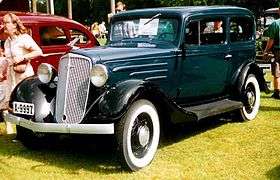Chevrolet Standard Six
The Chevrolet Standard (Series DC) was launched in 1933, initially as the Chevrolet Mercury, by Chevrolet as a lower priced alternative to the 1932 Chevrolet Series BA Confederate that became the Eagle in 1933[3] and Master from 1934.[4] It was advertised as the cheapest six-cylinder enclosed car on the market.[5]
| Chevrolet Standard Six | |
|---|---|
 | |
| Overview | |
| Manufacturer | Chevrolet (General Motors) |
| Also called | Chevrolet Mercury (1933 only) |
| Production | 1933 (Mercury) 1934–1936 (Standard) |
| Assembly | Oakland Assembly, Oakland, California North Tarrytown Assembly, Tarrytown, New York Flint Assembly, Flint, Michigan Norwood Assembly, Norwood, Ohio St. Louis Assembly, St. Louis, Missouri Oshawa Assembly, Oshawa, Ontario Canada Osaka Assembly, Osaka, Japan General Motors South Africa, Port Elizabeth, South Africa GM Argentina, Buenos Aires, Argentina GM Belgium, Antwerp, Belgium |
| Body and chassis | |
| Body style | 2-door coupe 2-door rumble seat coupe 4-door coach |
| Layout | FR layout |
| Platform | GM A platform |
| Related | Chevrolet Master |
| Powertrain | |
| Engine | 181 cu in (3.0 L) I6 206.8 cu in (3.4 L) I6 |
| Transmission | 3-speed manual[1] |
| Dimensions | |
| Wheelbase | 107.0 in (2,718 mm) 109.0 in (2,769 mm)(1936)[2] |
| Chronology | |
| Predecessor | Chevrolet Series BA Confederate |
| Successor | Chevrolet Master |
The Standard was offered in three body styles all on a 107-inch wheelbase: coach, coupe and coupe with rumble seat. All bodies were by Fisher and featured 'no-draft ventilation'. All models were powered by a 181 cu in (2,970 cc) six-cylinder valve-in-head engine producing 60 bhp (45 kW; 61 PS) at 3,000 rpm and 125 lb⋅ft (169 N⋅m) of torque[6] giving the car a top speed of between 65–70 mph. This engine had first appeared in Chevrolet's 1929 models, introduced in 1928. The car had full instrumentation.[7] A clock, heater and a radio were options.[1] For 1934, sedan, roadster and touring body styles were added to the catalog.
In 1935, a larger 206.8 cu in (3,389 cc) six-cylinder engine was offered in lieu of the 181 cu in (2,970 cc), producing 74 bhp (55 kW; 75 PS) at 3,200 rpm and 150 lb⋅ft (203 N⋅m) of torque. A sedan delivery was also available this year.
For 1936, the Standard Six received a wide range of improvements and a wider choice of body styles including cabriolet and sports sedan versions. It was built on a new box-girder frame with a wheel base of 109 inches.[8] With an increase of compression ratio from 5.6:1 to 6:1, the standard 206.8 cu in (3,389 cc) engine now produced 79 bhp (59 kW; 80 PS) at 3,200 rpm and 156 lb⋅ft (212 N⋅m) of torque which was now shared with the Master Six.[9] The spare wheel moved from its external rear trunk location to a new compartment under the trunk. Brakes were 11-in drums.[2] The steel roof was new.[10]
The Standard Six was discontinued for 1937 when the Master range was joined by the new Master Deluxe.[11]
References
- Kimes, Beverly (1996). standard catalog of American Cars 1805-1942. Krause publications. ISBN 0-87341-428-4.
- "Directory Index: Chevrolet/1936_Chevrolet/1936_Chevrolet_Brochure". Oldcarbrochures.com. Retrieved 2011-11-20.
- "1933 Chevrolet Eagle and Mercury". How Stuff Works. Retrieved 3 January 2013.
- "GM Heritage Center 1933 information sheet" (PDF). Archived from the original (PDF) on 2011-10-15. Retrieved 2011-11-20.
- The Tuscaloosa News - Mar 12, 1933 pg11
- "GM Heritage Center 1935 information sheet" (PDF). Archived from the original (PDF) on 2011-10-15. Retrieved 2011-11-20.
- "1934 Chevy Owner's Manual". Chevy.oldcarmanualproject.com. Retrieved 2011-11-20.
- "GM Heritage Center 1936 information sheet" (PDF). Archived from the original (PDF) on 2011-10-15. Retrieved 2011-11-20.
- the Auto Editors of Consumer Guide. "How Stuff Works". Auto.howstuffworks.com. Retrieved 2011-11-25.
- "Directory Index: Chevrolet/1936_Chevrolet/1936_Chevrolet_Brochure". Oldcarbrochures.com. Retrieved 2012-05-31.
- the Auto Editors of Consumer Guide (2007-09-19). "How Stuff Works". Auto.howstuffworks.com. Retrieved 2011-11-20.